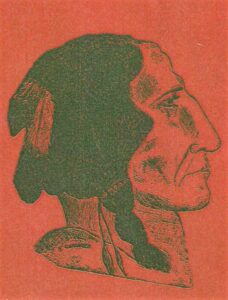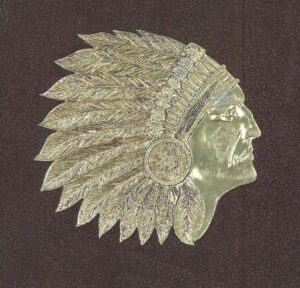By Marilyn May
Milford History

A more accurate picture of a Wepawaug Indian from the Milford High School 1929 yearbook.
The Milford High School class of 1929 had it right. The cover of their yearbook showed a profile of what a Wepawaug Indian actually looked like. In the 1965 yearbook, it seems that the Indian has sprouted feathers.
The picture from the Milford High School 1965 “Wepawaug” yearbook is a depiction of a Plains Indian shown wearing a ceremonial headress of feathers. It bears no resemblance to the indigenous people who lived in Milford.
The Memorial Bridge also has two likenesses of Ansantawae, but both have “crowns” of feathers. The Wepawag clan was part of the Paugusset Nation and was classified as Northeast Woodland Indians.
We have many misconceptions about the indigenous people of Milford who lived here for as many as 10,000 years.
A 1933 booklet by Connecticut’s Committee on Historical Publications told a story of “The Indians of Connecticut.” In it we learn that the Paugussetts had five clans that were sometimes thought of as distinct tribes but eventually were recognized as all one people. There were the Wipawaugs (Wepawaugs), Unkowas, Potatucks, Pomeraugs and the Naugatucks. Wepawaug means “crossing place.”
Marriage within a clan was forbidden but was allowed between clans, so there were many familial relationships among the early clans in this area. For example, the grand sachem in Derby was the father of Nunsantawae (Ansantawae) of Milford, and Ansantawae was the father of Ockenuck, sachem of Stratford. It became clear that the five clans were all from the Algonquin-speaking people of the Paugussett Nation in southern and western Connecticut.

A less accurate depiction of a Wepawaug Indian from the Milford High School 1965 yearbook.
In Milford (and in Orange), we are particularly interested in the lives of the Wepawaugs. The first Milford land sale in 1639 by the Wepawaugs to the English included the area between the East River (Indian River) and the Housatonic in the west. The southern border was Long Island Sound, including “Poquehaug,” later called Charles Island. The northern boundary was not so clear. The Paugussett did not go much beyond the villages of the Pomeraugs in what is now Woodbury and Middlebury because they feared attacks by the Mohawks, their long-time enemies.
The first sale of land from the Paugussett Wepawaugs to the English was followed by more land sales, until by 1665 the Wepawaugs had no place to live – no place to hunt or grow crops or harvest trees – because Ansantawae had sold most of the clan’s property. Then Milford granted them 100 acres on Turkey Hill which is now in Orange. But the once-thriving Wepawaugs were nearing the end of thousands of years of habitation here.
The word Paugussett is believed to have been derived from “pog-kussit,” which means “a swift current in a river where the channel is descending a rapid.” This sounds like the Wepawaug River, but the town we now call Derby was once called Paugussett, so the word may have referred to the Housatonic River.
The last sachem over a large number of Wepawaugs was Konkapotanauk (or Conquepotana), who died at his home in Derby in 1731. After his death, tribes were weakened, had no strong leaders and their numbers were declining.
What happened to the Wepawaugs? As best we know, the answer is that a small number stayed in Milford and eventually died out. Some joined the Potatucks (or Scatacooks) in Kent. The largest number joined the Iroquois Confederacy of upper New York state and southeastern Canada.
The word Iroquois does not define a tribe but rather a language spoken by people in a specific area. The indigenous people who brought all the Iroquois-speaking people together were the Haudenosaunee – the “people of the longhouse.”
There the Wepawaugs assimilated into the Onondaga, Cayuga, Oneida, Mohawk and Seneca tribes that made up the Iroquois Confederacy, also known as the Five Nations. After 1722, the Iroquoian-speaking Tuscarora people from the southeast were accepted into the confederacy, which then became known as the Six Nations.
It took years for the tribes to learn a new style of living, and that process has continued into the 21st century. As of 2019, there were 27,559 people registered in Six Nations.
The Iroquois Confederacy/Six Nations has been called the oldest living participatory democracy on earth, and in 1988 the US Senate paid tribute with a resolution that said, “The confederation of the original 13 colonies into one republic was influenced by the political system developed by the Iroquois Confederacy, as were many of the democratic principles which were incorporated into the Constitution itself.”
Democracy had taken root in North America among a handful of indigenous nations when between 1570-1600 the Haudensaunec united the Iroquois northeast woodland tribes. They dared to envision a new way of living.
After years of fighting and killing each other, they brought together the tribes to form a cooperative government. (As a united confederacy, they still fought with other tribes, such as the Hurons.)
Centuries before our founding fathers brought forth our system of governance, the Iroquois Confederacy/Six Nations established a model for federalism, separation of powers and participatory democracy that would inspire such leaders as Benjamin Franklin and James Madison during the formation of the US and the writing of the Constitution.
It must be said, however, that there are scholars today who debate how much effect the political system of the Iroquois had on the founding fathers.
What did happen to most of the Wepawaugs? Because we know that many assimilated into the tribes of the Six Nations, it would be nice to think that some of the indigenous Americans from Milford and Orange had a part in building, strengthening and sustaining this pioneering confederacy.
Marilyn May is a lifelong resident of Milford and a member of the Board of the Milford Historical Society.